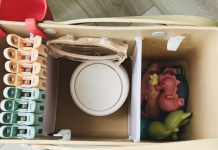Earlier in the year, I talked about how the idea of providing your child with an allowance helps them become more financially literate adults. However, providing the allowance or opportunities to earn money is only half the job. Now that they are getting money in hand, it is up to us to guide them with ideas on what to do with it. We can’t expect our children to become financially savvy adults without laying a financial foundation when they are young. I would also like to add, even though this article is about teaching young children what to do with their money, the principles I discuss can be implemented at any age.

Different Money-Saving Options for Kids & Tweens
GoHenry Card
The last time I gave you a financial update on my oldest daughter, she had $262 on her GoHenry debit card. We both agreed that that amount was plenty for her needs and that we should redirect her hard-earned cash to savings. Since then, she turned 12 and her $262 has accumulated to $310!
She was using her GoHenry card and some of the financial games and lessons provided sporadically, but not enough (in my opinion) to justify the $5.99 monthly fee. It was disheartening to tell her that her account balance decreased and it wasn’t due to her shopping or ice cream trips. So, we canceled her card and I’ve been holding onto her money until we found an appropriate financial vehicle.
For many people, the financial lessons, games and rewards and peace of mind tween debit cards provide could very well be worth the fee, but she’s frugal, doesn’t like the fees and I don’t see her overspending. Plus I’m a financial advisor that provides her financial lessons daily whether she likes it or not, so it just didn’t work for us. (I see a kiddie debit card review blog in my future…).
Joint Checking Account
We decided to do it the old-fashioned way and open up a joint checking account with a debit card at the bank. We explained to Maureen at the bank what we were trying to do and turns out, there are not many low-cost options available for a child under 13. She is too young to have her name on a checking account; you need to be 13 for that. The only way to get her name on an account was to open up an UGMA account. The Uniform Gifts to Minors Act (UGMA) allows individuals to give or transfer assets to underage beneficiaries. Once the beneficiary becomes of legal age (each state has a different age), the assets in the account become the beneficiaries for them to do as they please. The UGMA account could only be a savings account without a debit card, and I am not giving her money, it is hers to use now, so that doesn’t fit our needs. The checking accounts that have low to no fees and no balance minimums (depending on the bank) are for older teenagers, struck out again.
Maureen and I decided as a temporary solution, that I would open up a checking account with a debit card in my name and then when she is 13, we will add her name as the primary account holder and keep myself as the secondary. In order to avoid fees, we have to keep $100 in the account at all times. So, I tell my daughter, in order to avoid fees, to think of $100 in the account as $0 and if you have $101, you really only have $1.
This is a good strategy even for adults.
Your Lowest-Point Number Mindset
What is the amount that you like to see in your checking account? You may have never thought of it before, but there is a dollar amount that when you open your app on your phone and see your balance that your stomach starts to hurt and there is a dollar amount that makes you feel comfortable and secure. Try it out.
I do this exercise with my clients all the time. The beauty of it is that there really isn’t a right or wrong answer. Some people are OK when their balance gets to $500 because they know by that point their next paycheck will be coming and bring the balance back up and there are others who start to get nervous if their balance goes below $10,000. Operating from a mindset that your lowest point or the number that makes your stomach hurt is your $0, provides you the comfort that you have a cushion in case of emergencies or mistakenly over-spending. So, if you like to see at least $1,000 in your checking account at all times, that is your new dollar zero. If you have $1,100 in your checking account, that really means to you, that you have $100. What this does for you is that it reduces the fear of looking at your account and then you’re just looking at a number.
Remember, we are the ones that apply emotion to money, so if we remove the causes of emotion, then our relationship with money will improve.
Kids & Money Personality
My daughter now has her (my) new debit card and can access her money, minus $100. I will give a warning that this strategy does not work for every kid. Some of the benefits of the tween debit cards are that they put spending limits on the cards. Based on my daughter’s money personality, I know that she is not going to go hog wild and spend all her money in one place. And if she does, she will either experience the embarrassment of her card getting declined or one of her dog-sitting sessions will have to go to her bank fee. Good life lessons either way.
Another benefit of having a debit card at the bank is that she can set up her own Venmo and Zelle and her clients can send her money directly, instead of sending it to me, and then I have to remember and account correctly and send it to her account. Removing Mom as the middleman is always a good idea in my house.
 teaching young children what to do with their money, the principles I discuss can be implemented at any age. For my oldest, we have let her earn her money and when her cash on hand gets too large, we put money in the bank. When she wants to make a purchase, talk out the pros and cons and decide if the cost is worth it. She saves way more than she spends, and her conservative fiscal nature is showing me that she won’t need as many guardrails around her money as her siblings.
teaching young children what to do with their money, the principles I discuss can be implemented at any age. For my oldest, we have let her earn her money and when her cash on hand gets too large, we put money in the bank. When she wants to make a purchase, talk out the pros and cons and decide if the cost is worth it. She saves way more than she spends, and her conservative fiscal nature is showing me that she won’t need as many guardrails around her money as her siblings.
Every kid, and person, is different when it comes to money, so what works for one doesn’t for the other. To get children in the habit of making smart moves with their money, I like the idea of introducing to them the save, spend, give rule.
Save, Spend, & Give Rule
When you save, spend, or give, a portion of each dog-sitting gig, allowance, etc. goes to the child’s savings, a portion is held to spend at a future date and the last portion is given to a destination of choice.
I don’t have a recommendation for a percentage for each category, but instead, talk out the concept with your child and ask them what percentage they would like to save, spend, and give. It’s important to get their buy-in and make them feel like they are in control of the process.
If they have a big item that they want to purchase in the future, you can work backward and say in order to get to $200 in 6 months, you need to save $x each week from your allowance.
Their savings can be deposited in their piggy bank, or at the brick-and-mortar bank. I like the idea of having your child physically put their money somewhere versus Mom or Dad saying that they’ll take care of it for them or sending the money electronically to an account. By touching the money, taking it to the bank, and handing it to the teller, they can picture the account and their money “sitting” there for them and accumulating.
The spending part is obviously the most fun for your child. By allocating a certain percentage to their spending kitty, they know how much they have to spend and can make wise decisions.
Giving, or tithing, is a great way to see the good their money can do for others. It may be hard for a child to put their cash in the church basket on Sunday, but there are other ways they can give back. If there is a pantry in town for those in need, your child could use their money to purchase food to supply the pantry or if the local animal orphanage needs blankets or toys, they can purchase those items and deliver them to the orphanage.
My middle daughter, who is a spender, decided to spend her giving money on buying Girl Scout cookies for her troop. She justified it because a portion of the proceeds goes back to her troop! I guess we can call that a win-win.
Even though you are guiding your child to save and give back to others, you are empowering them to make their own choices and giving them confidence in their financial decisions.
As they get older, the save, spend, give strategy will change, but it is putting the foundation in place now for your children to always know they have to save a little bit of what they earn, control spending, and give back to others.













